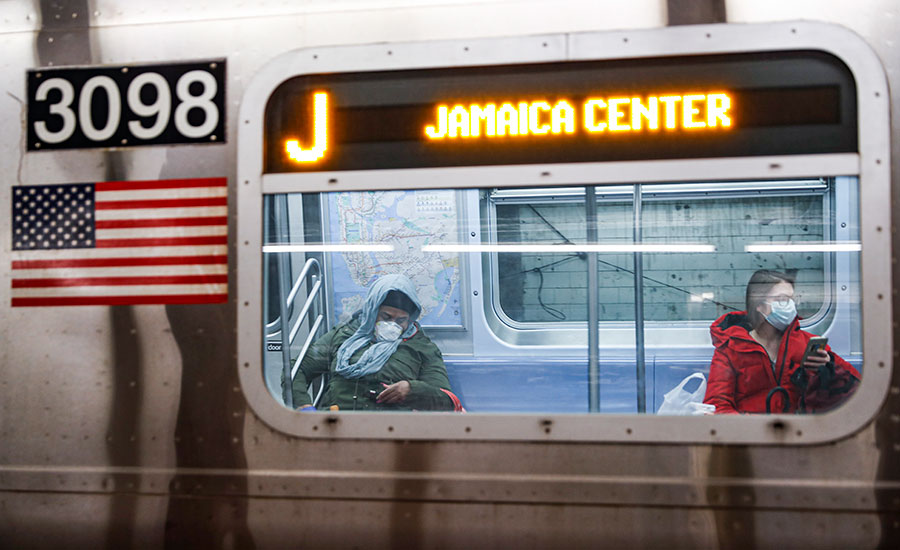Trump Signs $2-Trillion Stimulus Bill for COVID-19 Emergency

Subway riders wear protective masks and gloves on a sparsely populated car during morning hours in New York City. A stimulus package negotiated by Congress and the White House would provide money for cash-strapped metro systems.
President Donald Trump has signed the massive measure approved by Congress aimed at helping laid-off workers, financially strapped companies and a stressed health care system as a result of the coronavirus outbreak.
Final congressional action came on March 27, when the House passed the bill by voice vote. President Trump signed it a short time later.
Two days earlier, the Senate cleared the package on a 96-0 vote.
Under the final version—the product of a bipartisan Senate-White House agreement announced early on March 25—billions of dollars could go for infrastructure or other construction, including hospitals, airports and transit systems. The legislation’s overall total has been estimated at $2 trillion.
Other provisions would provide loans to help small businesses of all types, including engineering and construction firms, and direct payments to individuals.
But there’s a crucial caveat about the spending. In some cases, it would be up to states, localities and other recipients to determine how much of the broad-ranging grants or other types of aid would be devoted to operations and how much to construction.
Financially strapped aid recipients such as airports and transit systems might well decide to use the money to offset the dramatic revenue losses they have seen, rather than for construction projects.
Appropriations
Some of the construction funding is contained in the $339.9-billion appropriations section of the overall package. ENR calculates that infrastructure and construction could be eligible for at least $43 billion of that total.
Among the largest allotments is $25 billion for what are called “transit infrastructure grants.” But the legislation says funds can be used for transit systems’ “operating expenses related to the response to a coronavirus public health emergency,” or to cover lost revenue from the coronavirus outbreak.
Funds would be divided among U.S. transit agencies by existing formula.
Airport Grants
The legislation also has $10 billion in federal Airport Improvement Program (AIP) grants, to be distributed to airports by existing formulas.
AIP money has traditionally been focused on infrastructure projects, but the new legislation says nearly all of the $10 billion can be used “for any purpose for which airport revenues may lawfully be used.” That would seem to include non-infrastructure purposes.
Todd Hauptli, American Association of Airport Executives president and CEO, said the additional funds will assist airports that are “reeling from the impacts of coronavirus and the precipitous decline in travel that has occurred in a matter of a few short weeks.”
In a statement issued shortly after the Senate vote, Hauptli added that the $10 billion “will help keep people at work, avoid defaults on bonds, allow critical projects to continue and assist with recovery efforts that will be massive over time.”
In addition the measure provides $5 billion in Housing and Urban Development Dept. community development block grants, which can finance a wide variety of activities, including infrastructure.
DOD, VA Facilities
The legislation also contains $1.5 billion for the Dept. of Defense to expand military health facilities and modular field hospitals. Funds would almost triple the current total of 4,300 beds in U.S. military treatment facilities, according to a Senate Appropriations Committee Democrats’ summary.
The Dept. of Veterans Affairs’ appropriations allocation includes $606 million for VA medical facilities, including funds to develop other sites for providing health care services and for projects to modify infrastructure and utility systems at existing VA facilities to reconfigure them for coronavirus patients.
There also is $150 million in VA grants to states to modify or reconfigure existing veterans’ facilities, such as hospitals and nursing homes.
The Commerce Dept.’s Economic Development Administration is allotted $1.5 billion for grants to states and localities. In the past, infrastructure has been one of the activities eligible for such grants.
Senate Democrats’ lead negotiator, Minority Leader Chuck Schumer (N.Y.), said the overall package has a $150-billion infusion for the health care system, including “new construction to house patients.”
Elsewhere in the package is a $350-billion loan program for small businesses, which are prevalent in engineering and construction.
Tax Provisions
Stephen Sandherr, Associated General Contractors of America CEO, said in a March 26 statement that the Senate-approved legislation will provide construction contractors and workers “a needed lifeline to help them cope with a rapidly deteriorating business environment.”
He cited provisions providing access to capital, faster cash flow, protection for worker benefits and important tax incentives.
More specifically, AGC highlighted cash-flow-related provisions allowing companies to delay paying payroll taxes through next Jan. 1, and permitting firms to “carry back” net operating losses for five years, to offset past earnings. Another section of the bill allows firms organized as partnerships, S corporations and other pass-through entities to deduct all 2020 losses in the current tax year.
Talk of New “Recovery” Bill
House Speaker Nancy Pelosi (D-Calif.) already is talking about drafting further follow-on legislation. In a March 26 press conference, she described the Senate-passed measure as focusing on “mitigation” of the economic blow from the virus and the health care emergency. Pelosi added, “Next we’ll go from emergency mitigation to recovery,” with legislation to boost economic growth and create more jobs.
Sandherr agrees that there’s a need for additional legislation to “facilitate long-term recovery” and suggested including multiyear surface transportation and water resources infrastructure bills in that envisioned measure.
